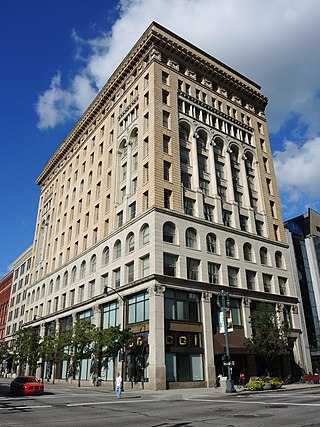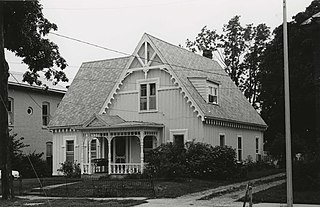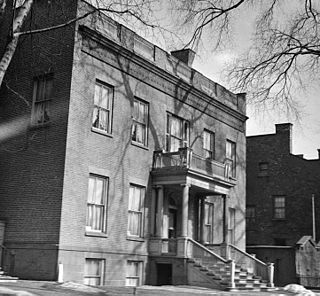
The Akin Free Library on Quaker Hill is a historic eclectic late Victorian stone building in the hamlet of Quaker Hill, town of Pawling, Dutchess County, New York, USA, listed in the National Register of Historic Places as a historic place of local significance since 1991.

The Central Troy Historic District is an irregularly shaped, 96-acre (39 ha) area of downtown Troy, New York, United States. It has been described as "one of the most perfectly preserved 19th-century downtowns in the [country]" with nearly 700 properties in a variety of architectural styles from the early 19th to mid-20th centuries. These include most of Russell Sage College, one of two privately owned urban parks in New York, and two National Historic Landmarks. Visitors ranging from the Duke de la Rochefoucauld to Philip Johnson have praised aspects of it. Martin Scorsese used parts of downtown Troy as a stand-in for 19th-century Manhattan in The Age of Innocence.

The Abrams Building was located at South Pearl Street and Hudson Avenue in Albany, New York, United States. It was a brick commercial building constructed in the 1880s. In 1980 it was listed on the National Register of Historic Places.

The New York State Education Building is a state office building in Albany, New York. It houses offices of the New York State Education Department (NYSED) and was formerly home to the New York State Museum and New York State Library. Designed by Henry Hornbostel in the Beaux-Arts style and opened in 1912, the building is known for its expansive colonnade.

The Second Baptist Church in Poughkeepsie, New York, United States, is located at the corner of Vassar and Mill streets. It is a wooden building from the late 1830s in the Greek Revival architectural style, the only remaining church in the city in that style.

The Watts De Peyster Fireman's Hall is located on Broadway in the village of Tivoli, New York. John Watts De Peyster, a resident, paid for it and gave it to the village for its fire department in 1898. It is a brick "storefront" firehouse, a type of fire station more commonly seen in cities at the time than small rural villages like Tivoli.

There are 75 properties listed on the National Register of Historic Places in Albany, New York, United States. Six are additionally designated as National Historic Landmarks (NHLs), the most of any city in the state after New York City. Another 14 are historic districts, for which 20 of the listings are also contributing properties. Two properties, both buildings, that had been listed in the past but have since been demolished have been delisted; one building that is also no longer extant remains listed.

The Batavia Club building, built originally as the Bank of Genesee, is on the corner of East Main and Bank streets in Batavia, New York, United States. It is a brick Federal style building from the 1830s, one of the few remaining examples in New York of a commercial building in that style from that period.

The Peekskill Presbyterian Church is a historic Greek Revival-style church located in Peekskill, New York, United States. It was built in 1846 and was twice the size of the original sanctuary which the congregation, dating to 1799 but formally incorporated in 1826, had outgrown.

The Officer Daryl R. Pierson Memorial Post Office Building is a historic post office building located at East Rochester in Monroe County, New York. It was designed and built 1936–1937, and is one of a number of post offices in New York State designed by the Office of the Supervising Architect of the Treasury Department, Louis A. Simon. The one story brick building is in the Colonial Revival style and has a roof crowned by a flat topped cupola. The entrance features fluted Doric columns and a blind fanlight with sculpted eagle. The interior features a mural titled "Recreation Hours" by Bernard Gussow

Rochester Savings Bank is a historic bank building located at Rochester in Monroe County, New York. It is a four-story, "V" shaped structure, sheathed in Kato stone from Minnesota. It was designed by McKim, Mead and White and built in 1927 to house the Rochester Savings Bank. The building's banking room interior features murals painted by noted artist Ezra Winter.

The Granite Building is a historic department store building located at 124 East Main Street in Rochester, Monroe County, New York.

Lehigh Valley Railroad Station is a historic railway station located at Rochester in Monroe County, New York. The Lehigh Valley Railroad built the station in 1905 but stopped using the station for passenger service in the 1950s. Later the station was used as a bus terminal and then as a night club. In the 1980s the building was added to the National Register of Historic Places and today it houses the Dinosaur Bar-B-Que restaurant.

Rochester City Hall is a historic government building in Rochester in Monroe County, New York. Also known as the Federal Building and Old Post Office, the building was originally built for use by the federal government. It is a four-story, Richardsonian Romanesque style structure with an inner court and tower. It was built between 1885 and 1889 of heavy brown sandstone with a metal skeleton. It was expanded in 1893 and in 1907. The building was designed in part by architect Harvey Ellis under the Office of the Supervising Architect Mifflin E. Bell. The building has served as the City Hall since the 1970s. It was listed on the National Register of Historic Places in 1972.

The Dr. Leonard Hall House was a private resident located at 334 West Main Street (M-34) in Hudson in westernmost Lenawee County, Michigan. It was designated as a Michigan Historic Site on April 4, 1978, and later added to the National Register of Historic Places on October 2, 1978.

Public School 17 is a historic school located at City Island in the Bronx, New York City. It was designed by architect C. B. J. Snyder (1860–1945) and built in 1897 in the Neo-Georgian style. A rear addition was built in 1930. It is a two-story, five-bay brick building on a high basement. It features a shallow wooden entrance porch with Doric order columns.

Brooks House, also known as the Hotel Brooks, is an historic building located at the corner of Main Street and High Street in downtown Brattleboro, Vermont. It was built in 1871 and designed by the architectural firm of E. Boyden & Son of Worcester, Massachusetts in the provincial Second Empire style for George Brooks, to replace a previous hotel on the site which had burned down. When it was completed, the luxury hotel had 80 rooms which were lavishly furnished. It was added to the National Register of Historic Places in 1980.

The New York Court of Appeals Building, officially referred to as Court of Appeals Hall, is located at the corner of Eagle and Pine streets in central Albany, New York, United States. It is a stone Greek Revival building built in 1842 from a design by Henry Rector. In 1971 it was listed on the National Register of Historic Places, one of seven buildings housing a state's highest court currently so recognized. Seven years later it was included as a contributing property when the Lafayette Park Historic District was listed on the Register.

The Knickerbocker and Arnink Garages were two attached stone buildings located on Hudson Avenue in central Albany, New York, United States. Both were built in the early 20th century; the Knickerbocker garage was added to the Arnink garage 12 years after it was built. In 1980, they were listed on the National Register of Historic Places; nine years later they were both demolished and delisted.

The Dr. Hun Houses were located on Washington Avenue on the western edge of central Albany, New York, United States. They were a pair of brick buildings constructed a century apart, the older one around 1830, in the Federal style. In 1972, three months after they were listed on the National Register of Historic Places, they were demolished and subsequently delisted.























